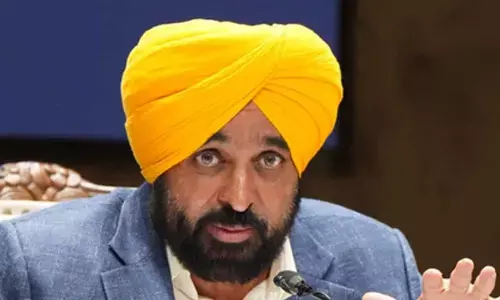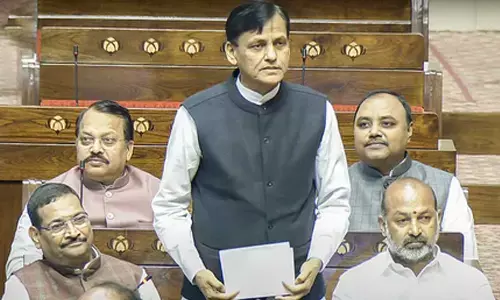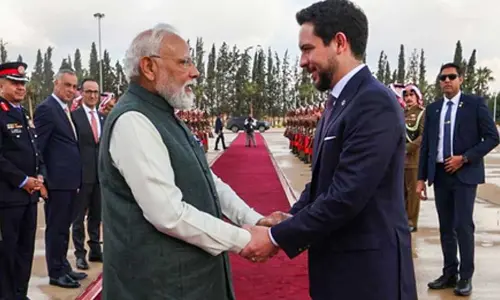Will fortune smile upon Rahul?

After the Congress-led alliance repeated its 2004 parliamentary victory in 2009, asked by a TV channel reporter about the fate of the Bharatiya Janata Party (BJP), I said political parties do not die; they survive electoral losses.
While these 5 state polls are crucial for Prime Minister Narendra Modi and the BJP, they are most critical for the Congress. If the Congress under Amrinder Singh bags Punjab, becomes part of a post-poll Akhilesh Yadav led government in UP, retain Uttarakhand, it could bounce back into business at the national level, giving Rahul the much-sought credibility
After the Congress-led alliance repeated its 2004 parliamentary victory in 2009, asked by a TV channel reporter about the fate of the Bharatiya Janata Party (BJP), I said political parties do not die; they survive electoral losses.
I recalled the BJP performance in 1984, after which it did exceedingly well. The footage was not used. My reply was not in tune with the moment.
I repeated this argument to another TV channel in 2014 about the Congress – do not write off a party that has been around for over a century. I failed to make it to the TV screens to score my own TRPs.
Indian politics is more unpredictable than any other democracy we know. There is no last word. Both parties have seen fluctuations – so have others. While the BJP has retained national prominence and hold in many states since 2014, the Congress, at its nadir in Parliament, has shown few signs of recovery in the last 30 months.
Fortunately for everyone, next month’s state assembly elections provide fresh opportunity for forging and breaking alliances and for reaching out to the people, even if to make promises and garner votes. For elections to Uttar Pradesh, Punjab, Goa, Uttarakhand and Manipur state assemblies, the parties’ manifestoes and a multi-media campaign full of toxic discourse have set the tone for the voting process that begins today.
While these polls are crucial for Prime Minister Narendra Modi and the BJP, they are most critical for the Congress. Its core crisis remains one of leadership. There is a virtual vacuum at the top. Sonia Gandhi is gradually taking the backseat, but Rahul Gandhi seems unable to connect at the popular level. Congressmen and women have tended not to accept each other in the leadership role and are stuck with the Gandhi family.
Even within this limitation, questions arise as the party joins the electoral race. If Priyanka plays a “larger” role in the campaign, as is being projected, will she click with the people? Her being a look-alike of grandmother Indira Gandhi can hardly excite young voters born after Indira’s assassination 32 years ago. If a seemingly more focused (than Rahul) Priyanka joins politics full-time, which she has refused so far, will she become another power centre and how will that impact Rahul’s leadership?
However, despite its current state, the party retains a pan-Indian character, and in its best form it represented India’s inclusive tradition, which still has a universal appeal. And without the much-needed course correction, it has become a player in UP after its alliance with the Samajwadi Party (SP). This has suddenly made things look up for the party that was earlier ranked fourth, destined to be an also-ran. Joint campaign by Rahul and Chief Minister Akhilesh Yadav, both young faces, could appeal to the young voter.
But the Congress’ role in UP, like in Bihar, is and would remain that of the tail of regional parties. Winning more seats in UP, as had happened in Bihar under Nitish Kumar’s leadership, would help it survive but restrict its stature and its scope to maneuver. Its current state compels it to accept this position.
There is room for criticism for a national party to be the ‘tail’ of a regional party. Come to think of it, the BJP also adopted this line for long years after its birth in 1980, building itself up gradually before L K Advani undertook his Rath Yatra and the party went about forging alliances.
And come to think of it, again, the Congress’s realisation, after years of decline, had come earlier in time for the 2004 elections. Not a mass vote-getter, Sonia had adopted this strategy, to be famously called a “political flirt” by Amar Singh. Both, Amar Simgh’s SP and Mayawati’s Bahujan Samaj Party (BSP) had spurned her. She persisted, even walking to the residence of her neighbour, Ram Vilas Paswan, and this yielded what was essentially a tactical victory over NDA to form government at the national level in 2004.
Both, the BJP in 2004 and the Congress in 2014, lost their support and the connection with the ground. Here comes the difference in the cadres they lead. Whatever its strength in parliament and in legislatures, the BJP has had the dedicated support of the Rashtriya Swayamsewak Sangh (RSS) and its myriad affiliate organisations. It has remained a cadre-based party unlike the Congress that is mass-based. The latter’s cadre-support on the ground has fluctuated depending upon its being in power and on being a vote-getting leader.
Both rivals, the Congress and the Aam Aadmi Party (AAP), are posing serious challenges in Punjab that is reeling under an anti-incumbency backlash against the government of Shiromani Akali Dal and BJP. Both are touted as the likely winner. The outcome is bound to have wide-ranging implications.
Should tiny Aam Aadmi Party (AAP) win in Punjab, it would emerge as a national player. It has so far skirted bigger states, leaving the fight among the biggies. AAP has, therefore, wisely chosen Gujarat, Punjab, Goa, Haryana and Manipur and bipolar states like Rajasthan and Madhya Pradesh to squeeze in and usurp the Congress space.
If he wins Punjab, Delhi Chief Minister Arvind Kejriwal may strive to go ‘national’, much to the BJP’s advantage as the AAP may then split anti-BJP, secular and Left-of-Centre space in 2019. Hence, an AAP rise would be suicidal for the Congress and by default, advantage BJP. An Akali-BJP victory in Punjab or that of AAP would severely undermine Congress’ bid to bounce back to provide a secular, national alternative to Modi in the 2019 Lok Sabha polls.
Look at another possible scenario. If the Congress under Amrinder Singh bags Punjab, becomes part of a post-poll Akhilesh Yadav led government in UP, retain Uttarakhand, it could bounce back into business at the national level, giving Rahul the much-sought credibility.
The picture cannot be complete without the Mayawati factor. The four-time chief minister has appeal for 20 per cent of the Dalit electorate and is reaching out to the Muslims the way she welcomed don-politician Mukhar Ansari into her party fold. Her weaning sizeable Muslim vote away from SP-Congress could work to the BJP’s advantage.
For BJP, the populous UP is important to be able to seek a fresh mandate in 2019, but more urgently and immediately, it needs to add to its Rajya Sabha tally for the Presidential elections later this year. A sweeping victory in UP would help the NDA get a majority in the electoral college to anoint a BJP nominee as the next President when incumbent Pranab Mukherjee demits office in July.
But then, at the height of the Modi wave and despite RSS cadres’ work on the ground, the BJP got only 31 per cent of the popular vote. Also, the BJP and its ally in UP, Apna Dal, captured 73 of 80 seats in the state. Thirty months hence, it seems impossible for the two to repeat that performance at the assembly level.
Modi remains popular even as he tries to carve out new constituencies amongst the poor. But there is also mounting dissatisfaction, movements are erupting, a manifestation of the growing agrarian, socio-political crises, reflected for instance in the Patidar agitation in Gujarat, the Maratha upsurge in Maharashtra, the Gujjar campaign in Rajasthan and the Jat violence in Haryana.
Although he is being projected as the mascot, this round of assembly polls may or may not be a test of Modi’s personal popularity. But most certainly, this will see the backlash of demonetisation that — whatever be the official claims and statistics – has certainly hit people of all classes. So, if demonetisation has unleashed the churning, like the Puranic ‘Amritmanthan,’ it is Modi and BJP that would have to consume ‘visha,’ the poison in the form of electoral setbacks.



















